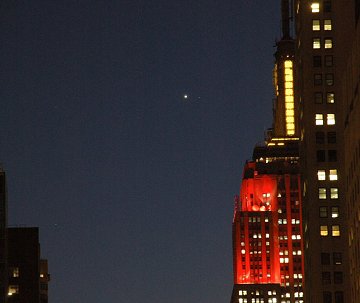 There's a lot happening in the sky. Would you like a call when it's time to look? Sign up for SpaceWeather PHONE.
There's a lot happening in the sky. Would you like a call when it's time to look? Sign up for SpaceWeather PHONE.
SOLAR WIND: A high-speed solar wind stream is buffeting Earth's magnetic field. Sky watchers in Alaska, Canada and Scandinavia should be alert for auroras.
 10 YEARS OF SOHO: Where would we be without SOHO? The orbiting Solar and Heliospheric Observatory (SOHO) keeps a 'round-the-clock eye on the sun and is crucial to space weather forecasting. Thousands of our readers have witnessed auroras only because SOHO spotted an incoming CME in time for us to issue an alert.
10 YEARS OF SOHO: Where would we be without SOHO? The orbiting Solar and Heliospheric Observatory (SOHO) keeps a 'round-the-clock eye on the sun and is crucial to space weather forecasting. Thousands of our readers have witnessed auroras only because SOHO spotted an incoming CME in time for us to issue an alert.
So it is with pleasure and appreciation that we wish a happy 10th anniversary to the SOHO team, whose spacecraft was launched on Dec. 2nd, 1995. Originally planned as a two year mission, SOHO is now entering its second decade. Amazing.
EXPANDING SUNSPOT: Sunspot 826 is growing quickly. Just yesterday it was a barely visible speck. Today it is a sprawling group of spots wider than the rings of Saturn. This SOHO animation shows the group's rapid evolution on Nov. 30th and Dec. 1st:

Yesterday, sunspot 826 unleashed an M1-class solar flare and now it is crackling with C-flares--a sign of things to come? Stay tuned for updates. Meanwhile, if you have a safely-filtered solar telescope, take a look at this 'spot. It's changing by the hour.
SHADOWS OF VENUS: Venus is reaching its peak brightness for 2005. How bright is it? You can see Venus in broad daylight, if you know where to look. And at night it actually casts shadows. (continued below)

Above: Venus rivals the city lights of 5th Avenue in New York City. Glowing red is the Empire State Building. Photo credit: Michael Millan.
Venus shadows are delicate, elusive, and if you appreciate rare things, a thrill to witness. Instructions: Find a dark site with no manmade lights--New York City won't work. When the sunset sky fades to black, while Venus is still well above the horizon, hold your hand in front of something white (e.g., a piece of paper or a white T-shirt) and let the shadows materialize. Not everyone can see them, but it's fun to look.

